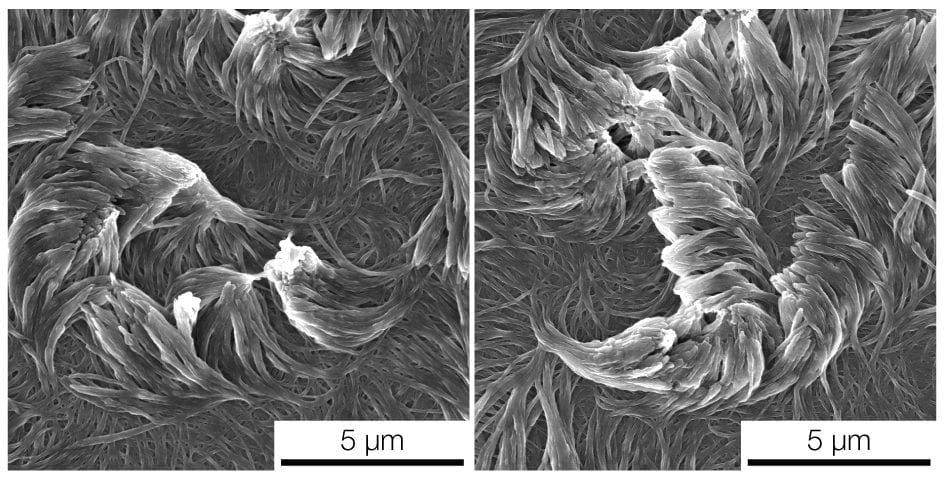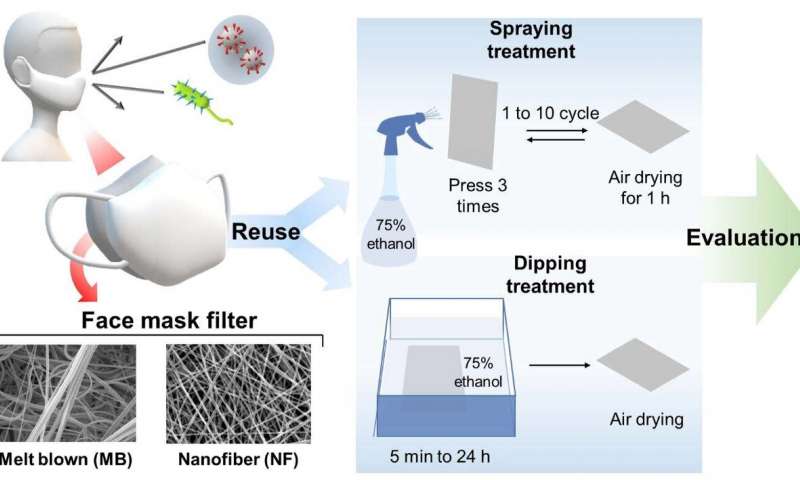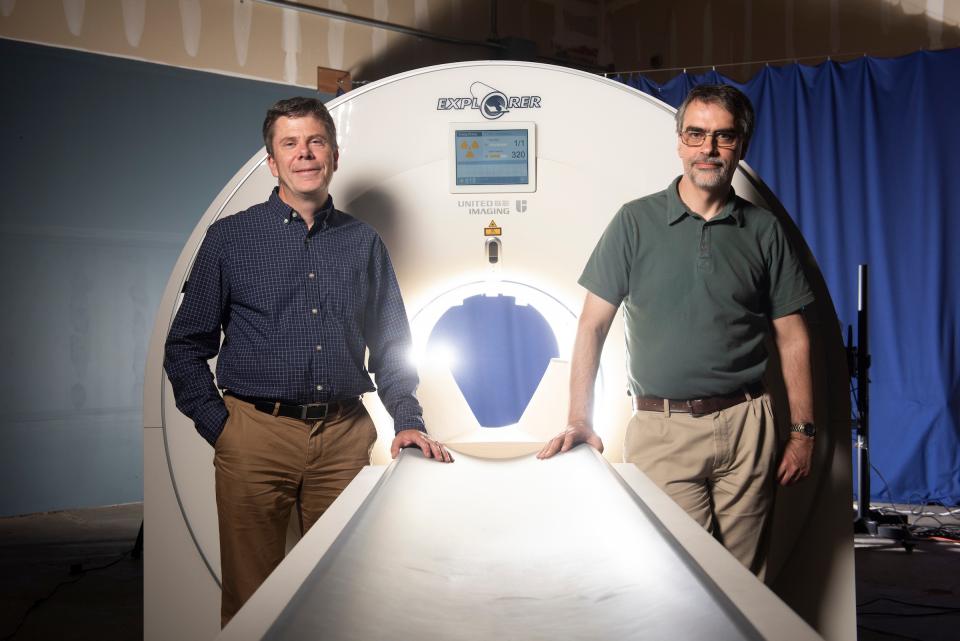
Inspired by the extraordinary characteristics of polar bear fur, lotus leaves and gecko feet, engineering researchers have developed a new way to make arrays of nanofibers that could bring us coatings that are sticky, repellant, insulating or light emitting, among other possibilities.
“This is so removed from anything I’ve ever seen that I would have thought it was impossible,” said Joerg Lahann, a professor of chemical engineering at the University of Michigan and senior author of the study in the journal Science.
Researchers at U-M and the University of Wisconsin made the somewhat serendipitous discovery, which revealed a new and powerful method for making arrays of fibers that are hundreds of times thinner than a human hair.
Polar bear hairs are structured to let light in while keeping heat from escaping. Water-repelling lotus leaves are coated with arrays of microscopic waxy tubules. And the nanoscale hairs on the bottoms of gravity-defying gecko feet get so close to other surfaces that atomic forces of attraction come into play. Researchers looking to mimic these superpowers and more have needed a way to create the minuscule arrays that do the work.

“Fundamentally, this is a completely different way of making nanofiber arrays,” Lahann said.
The researchers have shown that their nanofibers repelled water like lotus leaves. They grew straight and curved fibers and tested how they stuck together like Velcro—finding that clockwise and counterclockwise twisted fibers knitted together more tightly than two arrays of straight fibers.
They also experimented with optical properties, making a material that glowed. They believe it will be possible to make a structure that works like polar bear fur, with individual fibers structured to channel light.
But molecular carpets weren’t the original plan. Lahann’s group was working with that of Nicholas Abbott, at the time a professor of chemical engineering at UW-Madison, to put thin films of chain-like molecules, called polymers, on top of liquid crystals. Liquid crystals are best known for their use in displays such as televisions and computer screens. They were trying to make sensors that could detect single molecules.
Lahann brought the expertise in producing thin films while Abbott led the design and production of the liquid crystals. In typical experiments, Lahann’s group evaporates single links in the chain and coaxes them to condense onto surfaces. But the thin polymer films sometimes didn’t materialize as expected.
“The discovery reinforces my view that the best advances in science and engineering occur when things don’t go as planned,” Abbott said. “You just have to be alert and view failed experiments as opportunities.”
Instead of coating the top of the liquid crystal, the links slipped into the fluid and connected with each other on the glass slide. The liquid crystal then guided the shapes of the nanofibers growing up from the bottom, creating nanoscale carpets.
“A liquid crystal is a relatively disordered fluid, yet it can template the formation of nanofibers with remarkably well-defined lengths and diameters,” Abbott said.
And they didn’t only make straight strands. Depending on the liquid crystal, they could generate curved fibers, like microscopic bananas or staircases.

The study is titled “Templated nanofiber synthesis via chemical vapor polymerization into liquid crystalline films.”
Learn more: Nanofiber carpet could lead to new sticky or insulating surfaces
The Latest on: Nanofiber coatings
[google_news title=”” keyword=”nanofiber coatings” num_posts=”10″ blurb_length=”0″ show_thumb=”left”]
via Google News
The Latest on: Nanofiber coatings
- How Much Does It Cost To Epoxy Garage Floor?on April 18, 2024 at 3:42 am
Epoxy is a resin material that will be mixed with hardening agents so that when it cures you are left with a coating that is able to withstand heavy use. This is why the epoxying method is favored ...
- How CMOs Should Embrace Authenticity In Hispanic Marketing Beyond Latino Coatingon April 16, 2024 at 9:00 am
Yet, amidst the vibrant tapestry of cultures, there lies a prevalent issue that often goes unnoticed - Latino Coating. What exactly is Latino Coating, and why is it a cause for concern in the ...
- Paint and coatings industry worldwide - statistics & factson April 11, 2024 at 5:00 pm
The Asia-Pacific region constitutes the largest paint and coatings industry worldwide, with a market share of 45 percent in 2022. The region's commanding share of the market is expected to expand ...
- Best ceramic coatings for cars in 2024on April 8, 2024 at 2:15 am
Pricing and availability are subject to change. A high-quality ceramic coating can be the final cherry on top of a car detailing sundae. If you're an enthusiast who loves to keep your car in tip ...
- Marine Coatings: GIT and WEG Partneron April 7, 2024 at 5:00 pm
Brazil-based WEG Coatings and Canadian-based GIT Coatings have entered an agreement to strengthen each other’s marine coating product offerings across international markets. The partnership aims ...
- New window film drops temperature, slashes energy consumptionon April 4, 2024 at 8:16 pm
Existing window coatings tend to be optimized for light that enters at a 90-degree angle, so their ability to block light depends on this so-called solar incident angle.
- Sunrise to sunset, new window coating blocks heat — not viewon April 2, 2024 at 11:15 am
Researchers at the University of Notre Dame have developed a new window coating to block heat-generating ultraviolet and infrared light and allow for visible light, regardless of the sun’s angle.
- Sunrise to sunset, new window coating blocks heat -- not viewon April 1, 2024 at 5:00 pm
Sunrise to sunset, new window coating blocks heat -- not view Date: April 2, 2024 Source: University of Notre Dame Summary: Windows welcome light into interior spaces, but they also bring in ...
- What Is Powder Coating?on December 20, 2023 at 2:00 am
Except maybe for chrome or nickel plating, nothing beats a powder-coating finish. It's like jewelry for car parts! Powder coat is a dry paint similar in texture to baking flour. After it has been ...
via Bing News










